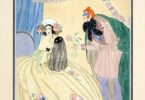
Jews give great importance to recording and preserving their history, starting with the Bible. Museums are an obvious extension. Today there are Jewish museums all over the world. Some are adjacent to synagogues, for instance in Cape Town and Buenos Aires, or are installed in deconsecrated synagogues, e.g. in Amsterdam, but most are stand-alone structures with curators, docents and other staff.
In the summer of 1938, as tens of thousands of Jews were fleeing Nazi Germany and Austria, delegates from 32 countries met in the French resort of Evian on the edge of Lake Léman (Lake Geneva) to discuss the plight of the Jews. At the conference, only Rafael Trujillo, dictatorial President of the Dominican Republic, offered to accept any refugees. Representatives of all of the other countries, including the United States, refused, only going so far as to say, in effect, “what a shame.” President Roosevelt demonstrated his lack of concern by sending a businessman friend of his instead of a government official.
Trujillo offered to accept up to 100,000 Jewish refugees. In the end only about 800 arrived. They settled in a village known as Sosúa, where they created farms and factories and had a positive impact on the economy. Some descendants of the original settlers are still there. They remain an important part of the community and maintain a synagogue and a small museum about their community.
Most Jewish museums focus on the history of the Jews in the specific country, secondarily on the history of Jews worldwide. Some have sections focused on the Holocaust while some are specifically Holocaust Museums. Jewish Museums are not religious institutions. However, virtually every Jewish museum displays some religious artifacts because they are essential to the culture. As someone who has visited a plethora of historic sites and museums around the world, I don’t think there’s a parallel of any kind to the array of Jewish museums.
Many Christian churches have a vestry or sacristy where vestments (liturgical garments), reliquaries and other religious articles are stored and often are displayed. Some sacristies serve as small museums, even to the extent of charging admission fees. But they are fundamentally religious institutions, not museums.
Prior to World War II Jews comprised approximately one third of the population of Lithuania. In 1812 Napoleon called Vilnius, the capital city, “the Jerusalem of the North.” However, during World War II the Germans killed 90% of the Lithuanian Jews.
In Vilnius there’s a small Jewish Museum as well as a separate Holocaust Museum. Sadly, when I visited about 22 years ago, the Jewish Museum had almost nothing to display. During the war the local population, including friends and neighbors of deported and murdered Jews, had done everything they could to eradicate the community, burning their books and melting ceremonial objects such as Torah Crowns, Menorahs, Kiddush cups and Shabbat candle holders.
In the many Jewish museums I have visited I have often been astounded by the beauty of the exhibits, religious as well as secular. Secular collections often include images or mock-ups of old houses, with original personal items and clothing that shed light on life in earlier times. They often present shows about Jewish artists, for example Camille Pissarro, Marc Chagall, Chaïm Soutine, Amedeo Modigliani, Diane Arbus and the photographer Robert Capa, among many others.
As a (secular) Jew I’m always interested in visiting Jewish museums when I’m traveling. They are always edifying. Also, as a publisher of microfilms I have worked with Jewish museums, preserving Jewish documents, newspapers and books in ten countries. In Warsaw, at the Jewish Historical Institute, I filmed the only Jewish newspaper published in the Ghetto during World War II. Nearby today is the huge Museum of the History of Polish Jews, which did not exist when I was last in Warsaw.
There are Jewish museums in almost every major country in Europe, and others elsewhere around the world, for instance, in China, Morocco and Guatemala. At least 40 countries have Jewish museums. Clearly, one of the reasons there are so many Jewish museums around the world is
because there were (and are) Jewish communities all over the world. Adjacent to the Jewish Museum in Cochin, India is a store run by a Mrs. Cohen, who told us that the community there dates back 2,000 years. Sadly, shortly after we visited the Jewish Museum in Mumbai, several Jews were murdered by the same terrorists who attacked the famous Taj Hotel nearby.
In Moscow, in the late 19th century, the Jewish community was given permission to build a large stone synagogue, known today as The Moscow Choral Synagogue. This building is quite different from the myriad small wooden synagogues that were burned down during the many pogroms over the centuries. However, shortly after it was built, a Russian official alighted from his carriage in front of the building thinking it was a church; he knelt and said a prayer. Upon learning that the building was a synagogue, he demanded the demolition of its dome, which wasn’t replaced for 100 years.







There are now two Jewish museums in Moscow. The Jewish Museum and Tolerance Center is in a huge, former garage and is dedicated to the history of Russian Jewry, with a section on the Holocaust. Ultra-modern and technologically sophisticated, it was created with money from Russian Jewish oligarchs. Also in Moscow is the tiny Museum of Jewish History in Russia, which survives in several rooms in an apartment house and is hard to find. The Russian Ethnographic Museum in St. Petersburg has a large exhibit of Judaica, including some of the famous Ansky Ethnographic Collection. Many other museums around the world have Judaica collections.
“As a (secular) Jew I’m always interested in visiting Jewish museums when I’m traveling.”
The architect Daniel Libeskind designed the Jewish Museum Berlin to convey to visitors a sense of confusion and disorientation, similar to what one experiences in the Holocaust Memorial near the Brandenburg Gate and in the Holocaust Museum in Washington, DC. The museum first opened in 2001. It is primarily a museum about German Jews.
Cologne (Köln) formerly home of one of the oldest and most prominent Jewish communities in Germany. The Museum Ludwig, which has a small Judaica collection, hovers over an archaeological site of a medieval community, which will eventually become an underground Jewish Museum.
There are several Jewish museums in Vienna. At Judenplatz, in the heart of a former Jewish community, there’s a small museum and a memorial to the Holocaust. Vienna is also home to the Austrian Jewish Museum.
The Kindertransport was an effort begun prior to the outbreak of Wold War II to rescue Jewish children by transporting them to England from Nazi-controlled territory. The Jewish Museum in London organized a show about this some years ago. I was fortunate to meet a man in Italy named Durst, who was one of the rescued survivors, who told me his life story.
During World War II Hitler was planning to build a museum and library in Prague after the war to preserve the history of the Jews he had annihilated. During the war his armies collected Jewish books all over Europe and transported them to Prague. Thus there are more Jewish books in Prague today than before the war. The Jewish Museum in Prague includes the library and the famous old Jewish Cemetery with its mélange of ancient tombstones, and has exhibits in five former synagogues.







Greece is among the many European countries with historical Jewish communities. Thus there is a Jewish Museum in the heart of Athens, and another in Rhodes. Both are attached to ancient synagogues. The Jewish Museum in Budapest is inside the beautiful Dohany Synagogue, and includes a memorial to the Holocaust.
In Bucharest the also beautiful, much smaller synagogue, is now a museum. In Pitesti, Romania, where my grandfather was born, there is no museum, but his synagogue remains intact and in use. In Brest-Litovsk, near where my grandmother was born, the nascent Jewish community, none of whom are local survivors, but rather are Russian immigrants, has begun creating a museum.
In many parts of Europe there are former concentration and death camps. However, the extent to which the former barracks and killing places, for instance at Auschwitz, are made to resemble museums, is disturbing. Nearby, Birkenau, sitting mostly as it was when the Germans fled, is far more moving. Many years ago, finding ourselves alone and seemingly locked in a former gas chamber at closing time in Mauthausen, did not convey to us a sense that we were in a museum. Ergo, I don’t consider any of the former concentration camps to be museums.
To visit the Jewish Museum in Buenos Aires it was necessary to reserve in advance and to present proper credentials. While we much enjoyed our visit in 2019, we were very saddened to learn that the director had been attacked in his own home the previous night. Fortunately, he survived.
There are many museums in Israel, including the Israel Museum in Jerusalem, with extensive holdings and the Dead Sea Scrolls. The relatively new ANU Museum of the Jewish People in Tel Aviv is perhaps the most comprehensive Jewish museum in the world. Finally, because it stands as a memorial to the six million who died, Yad Vashem in Jerusalem is the most important Holocaust museum in the world.
There are at least 50 Jewish Museums around the United States. Perhaps half are nested in synagogues or Jewish Centers. Here in New York City we have two: The Jewish Museum, founded in 1904, was the first to showcase contemporary art by Jews; The Museum of Jewish Heritage is largely focused on the Holocaust, but years ago had a show about Sosúa, which served as my introduction to the story. There is also the Center for Jewish History, which houses several of the most important Jewish research organizations in the United States.
According to my observations, Jewish travelers tend to visit museums of all types, but tend to go out of their way to visit Jewish museums. At the same time, Jewish museums are partly an effort by their creators to present Jewish history and culture in a positive light in hopes that doing so will help in the fight against antisemitism. Seeing so many Jewish museums (and old synagogues) around the world has brought home to me the extent and history of the Jewish diaspora and has constituted an incredible learning experience, reinforcing my appreciation of being Jewish and part of a culture, and of “culture” itself, which we all share.
G&S
All photographs by Norman A. Ross





Leave a Comment